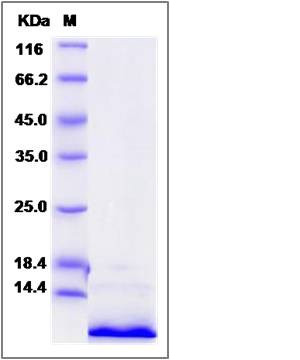Human CXCL5 Protein
ENA-78,SCYB5
- 100ug (NPP1218) Please inquiry
| Catalog Number | P10889-HNAE |
|---|---|
| Organism Species | Human |
| Host | E. coli |
| Synonyms | ENA-78,SCYB5 |
| Molecular Weight | The recombinant human CXCL5 consists of 71 amino acids and predicts a molecular mass of 7.8 KDa. It migrates as an approximately 8 KDa band in SDS-PAGE under reducing conditions. |
| predicted N | Met |
| SDS-PAGE |  |
| Purity | > 95 % as determined by SDS-PAGE |
| Protein Construction | A DNA sequence encoding the human CXCL5 (P42830) (Arg45-Asn114) was expressed, with a N-terminal Met. |
| Bio-activity | |
| Research Area | Cardiovascular |Atherosclerosis |Vascular Inflammation |Leukocyte recruitment |Chemokines in Leukocyte recruitment |
| Formulation | Lyophilized from sterile 80% acetonitrile, 0.1% TFA, 20% H2O 1. Normally 5 % - 8 % trehalose, mannitol and 0.01% Tween80 are added as protectants before lyophilization. Specific concentrations are included in the hardcopy of COA. |
| Background | CXCL5 is a small cytokine belonging to the CXC chemokine family. CXC chemokines are particularly significant for leukocyte infiltration in inflammatory diseases. CXCL5 is produced following stimulation of cells with the inflammatory cytokines interleukin-1 or tumor necrosis factor-alpha. It also can be detected in eosinophils, and can be inhibited with the type II interferon. CXCL5 plays a role in reducing sensitivity to sunburn pain in some subjects, and is a potential target which can be utilized to understand more about pain in other inflammatory conditions like arthritis and cystitis. It stimulates the chemotaxis of neutrophils possesses angiogenic properties. It elicits these effects by interacting with the cell surface chemokine receptor CXCR2. |
| Reference |
